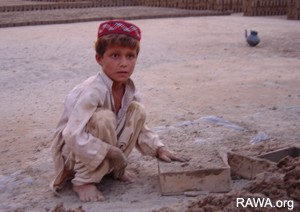By Jonathon Burch
Half of Afghan children are still not going to school and the biggest group missing out on an education are girls, the United Nations said on Monday.


IRIN News, January 16, 2007: A survey released by the AIHRC revealed that 60 percent of families surveyed stated that almost half their children were involved in some kind of labour.
The Taliban banned girls from school when they were in power from 1996 to 2001, but there are now more girls in education than there were boys at school under the hardline Islamists.
There are also more Afghan children in school now than ever before, but many problems remain.
"In Afghanistan, despite the progress in school enrolment over the last two years, half of school-age children are estimated to be out of school," Shigeru Aoyagi, country director of UNESCO in Afghanistan, told a news conference in Kabul.
Working children, street children, children in prison and disabled children were among those excluded, the U.N. said, but by far the biggest group are girls.
"We still have 1.2 million girls of school age who do not have access to school in this country," Catherine Mbengue, head of UNICEF in Afghanistan, told the news conference.
The main reasons for girls missing out on school were that many of them either work to support their families or marry young, Mbengue said. There is also a lack of woman teachers.
The literacy rate for women aged 15-24 in Afghanistan is 14 percent compared with 51 percent for men.
Nearly 150 Afghan students and teachers were killed and around 100 schools burnt down by Taliban militants in the Afghan year that ended in March, the Education Ministry said, but a record 5.7 million children are now in education.
But of those attending school, only 35 percent are girls and while the number of Afghan schoolchildren is going up, the proportion of girls in education has stayed the same, an aid group said on Monday.
The lack of women teachers, only 28 percent of the total, meant parents were often reluctant to send their daughters to be taught by men. Parents were also reluctant to send their girls to schools too far from the home, CARE International said.
Around a third of state schools were exclusively for boys, CARE said, but the number of girls in education could be increased cost-effectively by alterations to these existing buildings to ensure segregation of the sexes demanded by conservative Afghan culture or by different time-tabling for boys and girls.
Parents also need to be convinced of the value that Islam places on the education of girls, it said.



